
Hyundai car cover works like a miniature microclimate controller wrapped around your car. Picture three familiar American moments: at noon in Arizona you open the door and heat rushes out like an oven; a drizzly night in Seattle leaves faint water frames around the glass by morning; or a salt-covered road in Michigan after a snowstorm makes chrome and bright trim look tired after a single season. The common thread is that surfaces are constantly stress-tested by sun, water and fine dust. Instead of reacting with expensive washing and polishing, a Hyundai car cover that is engineered on the right physical mechanisms lets you cut the cause at the source. The outer face sheds water so droplets roll off, the core breathes so vapor escapes upward, the ultra soft liner turns contact into a cushioned touch, and a stable form keeps the cover still in the wind. When these four pieces run together, your car ages noticeably slower, from paint and glass on the outside to dash, seats and seals inside.
Related Articles: Hupmobile car cover: full coverage, interior protection, anti-mold and anti-rust to keep your car looking new
Why Hyundai vehicles need a cover with the right mechanisms rather than “thick for peace of mind"
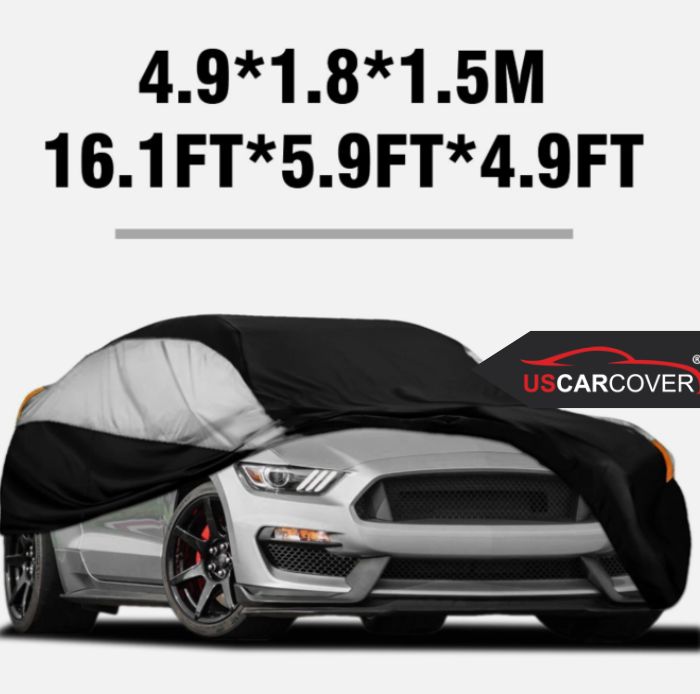
On modern Hyundai models, beauty comes from large steep glass, panorama roofs, sharp paint creases, bold black plastics and bright chrome, plus a ring of ADAS sensors around the body. That architecture makes surfaces sensitive to two groups of stressors: energy (UV and heat) and moisture plus dust (rain, dew, sea salt, road salt, fine particulates). If you simply pick a very thick cover to feel secure, you can trap moisture underneath, leaving the underside clammy for days, the cabin musty, glass edges imprinted with water frames, and fine dust pinched between fabric and paint that acts like invisible sandpaper when wind funnels through. A proper Hyundai car cover does not chase thickness. It builds a coordinated mechanism: an outer face that beads water so it leaves quickly, a micro-vented core that carries vapor up and out, an ultra soft liner so every on and off is not micro-abrasion, and a form shaped to sedans, SUVs or EVs so the cover stays put even in wind. The deeper reason is that nearly all damage needs either wet time or wind-driven vibration to accumulate. Cut those two conditions and you cut the problem at its root.
Next-gen fabric architecture: the beading, breathing, soft-touch and stay-still mechanism
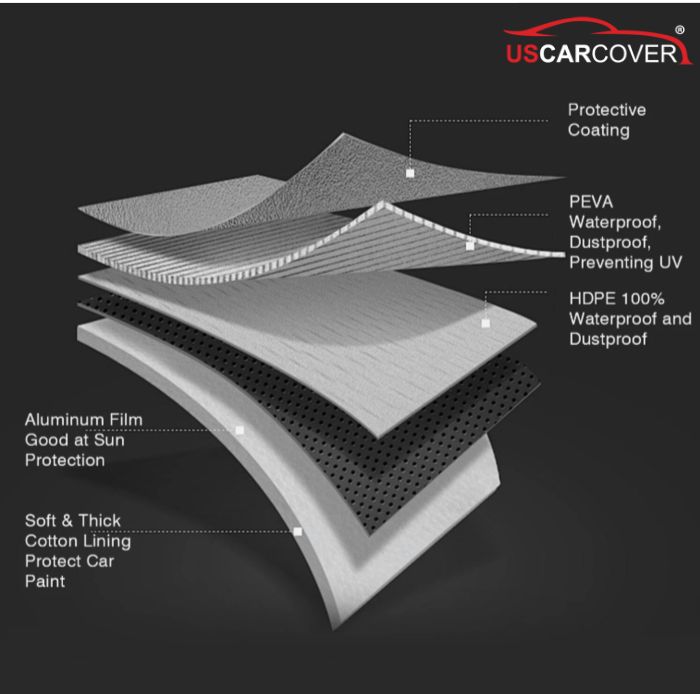
To see why a modern Hyundai car cover works better, think of it as a layered architecture. The top layer is finished so rain or dew forms round droplets instead of spreading. Thanks to the natural slope of the hood and glass, droplets roll away, shortening wet time and lowering the chance of mineral spotting on glass and lingering water along trim edges. Beneath that sits a breathable core with a network of micro-pores that is dense enough to guide vapor from the vehicle surface upward, yet small enough to keep rain from wicking downward. That direction of travel keeps the underside dry across days rather than repeating the pattern of dry for hours and clammy again that airtight fabrics cause.
The next tier is the ultra soft liner, the layer that touches paint, glass and chrome. With brushed, color-stable fibers, every contact becomes a cushioned touch, which is especially important if the car has fresh paint, ceramic coating or PPF. Finally comes the structural tier made of a stable form, recessed seams and soft hems. A model-correct form suppresses air pockets at the nose and rear glass, preventing ballooning. Recessed seams bury the fabric edge so it does not press into glass. Soft hems keep the cover from “drawing lines” along crisp creases. The synergy of these four tiers creates a big difference between a heavy, airtight tarp and a Hyundai car cover that is light, evenly breathing, beads water, touches softly and stays still.
Related Articles: Hummer car cover for indoor or outdoor: choose based on needs, climate, parking context, and off-road frequency
Under the sun: UV, heat and why reflectivity matters more than thickness
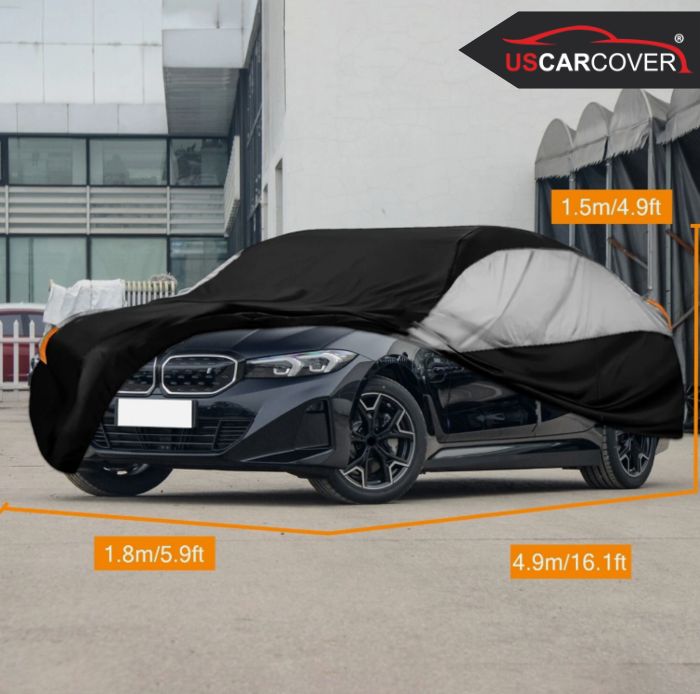
In the Sun Belt, intense sun does more than make the cabin uncomfortable. UV breaks polymer chains in black plastics and fades them, high heat dries leather and cloth, and adhesives under veneer and around glass are stressed for long periods. Many people reach for a dark, thick fabric to “block sun,” but dark fabric absorbs radiation and re-radiates it downward, while thick, non-breathing fabric traps heat against the surface.
A Hyundai car cover that truly works in the sun must prioritize solar reflectivity and vapor movement. A light, reflective outer face cuts the heat load entering the cabin. A breathable core lets moisture generated by hot surfaces travel upward instead of pooling as warm humidity. The ultra soft liner ensures every midday on and off is not a rough rub. On models with a panorama roof like Palisade, Santa Fe or Ioniq 5, shading the roof noticeably reduces cabin temperature and extends the life of seals and adhesives around that large glass panel. If you skip these principles, black plastics gray out in a few seasons, the dash hairline checks, light seats yellow and the cabin carries a sun-baked smell. The fix lies in the reflect, vent and soft-touch mechanism of a Hyundai car cover, not in “thicker and heavier."
Related Articles: Hudson car cover: Scratch protection, rain beading, fast moisture release, lasting chrome shine, fewer water spots on glass
In the rain: water spots, musty odor and how to end glass-edge water frames
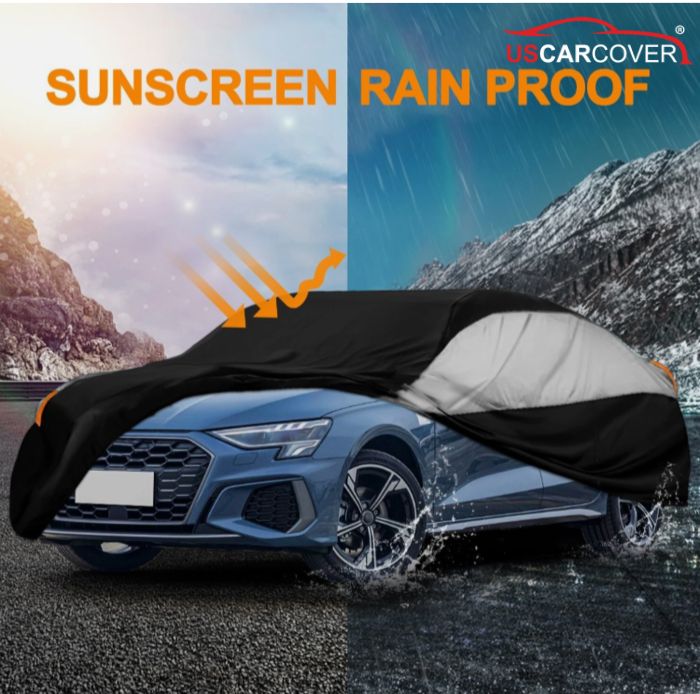
In areas with long, light rain like the Pacific Northwest or neighborhoods with sprinklers, a specific type of damage shows up: chalky frames at glass edges, stubborn water marks baked on the hood, and a faint musty odor inside. The cause is simple. Droplets sit too long and are “held in place.” When water evaporates, minerals remain on glass, and trapped vapor under a sealed cover makes the cabin smell.
A Hyundai car cover solves this with two actions at once. First is beading to shorten wet time. The faster droplets leave, the fewer chances minerals have to crystallize into frames. Second is breathing from below upward, which keeps the underside dry across days instead of clammy. A cover that stays still in wind also prevents fine dust from being dragged across paint during windy, rainy nights. If you ignore this, glass grows progressively dull at the edges, you see circular water marks on paint, and the interior carries a lingering damp smell. Use the right Hyundai car cover and add one small habit after a long rain. Lift a corner for a few minutes to exchange air, then close it again when surfaces have settled. Water frames disappear, paint looks clean, and the cabin stays neutral.

Related Articles: Honda car cover: rain resistant, strong UV protection, cooler cabin, durable paint and interior
In wet snow and road salt: shorten wet time and avoid salty greenhouses
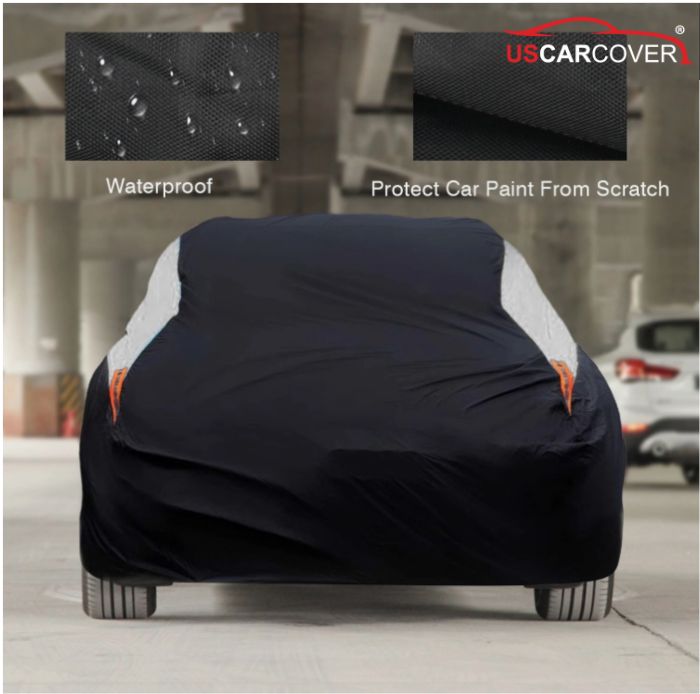
In the Snow Belt, the real threat is salty water. When snow cycles between melting and refreezing, brine sits along glass and bright trim, especially on wind-facing areas at the front. If the cover balloons and collapses with gusts, salt particles move and rub, accelerating chrome pitting and glass-edge staining. The result is quick loss of depth on brightwork, grimy glass edges and dulled trim.
A Hyundai car cover for these conditions needs strong beading so droplets leave quickly, a micro-vented core so there is no salty greenhouse under the cover, and stability so salt cannot move and abrade. When you remove the cover, give it a light shake so salt falls off before storage, and the protection loop closes. After one season you will see deeper chrome shine, cleaner glass edges and paint without salty blotches. Skip this mechanism and the end-of-season chrome and polishing bill often equals or exceeds the cost of a proper Hyundai car cover from the start.
Scratches and swirl marks: fine dust plus wind-induced movement is invisible sandpape
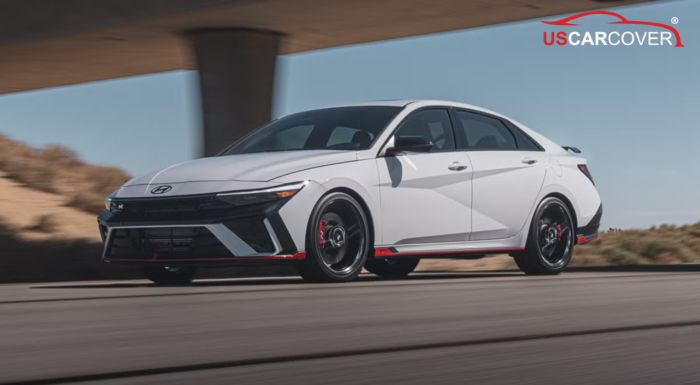
On deep black or blue Hyundai paint, swirl marks show up instantly in sunlight. The usual source is not the fabric itself but loose form that creates micro-movement, plus fine dust pinched between the cover and the surface. Every wind gust is a cycle of balloon and collapse. Tiny particles like pollen, fine sand or wildfire ash move back and forth and behave like ultra-fine sandpaper. Large flat areas such as the hood and glass show it first.
The remedy is to stop the cause at the source with an ultra soft liner to kill repetitive friction, a stable form to suppress air pockets, and recessed seams with soft hems so edges do not press into glass or sharp creases. Handling habits matter too. Let the fabric fall in its natural direction rather than dragging sideways, brush off large grit before covering, and if the surface is wet, allow a quick flash-dry before you put the cover on. Combine these and the Hyundai car cover preserves flat, glossy paint over time, instead of relying on corrective polishing later.
Related Articles: Hillman car cover: preserve value and extend vehicle lifespan, reduce repair and maintenance costs
Choose a Hyundai car cover by U.S. climate: turn your environment into clear criteria
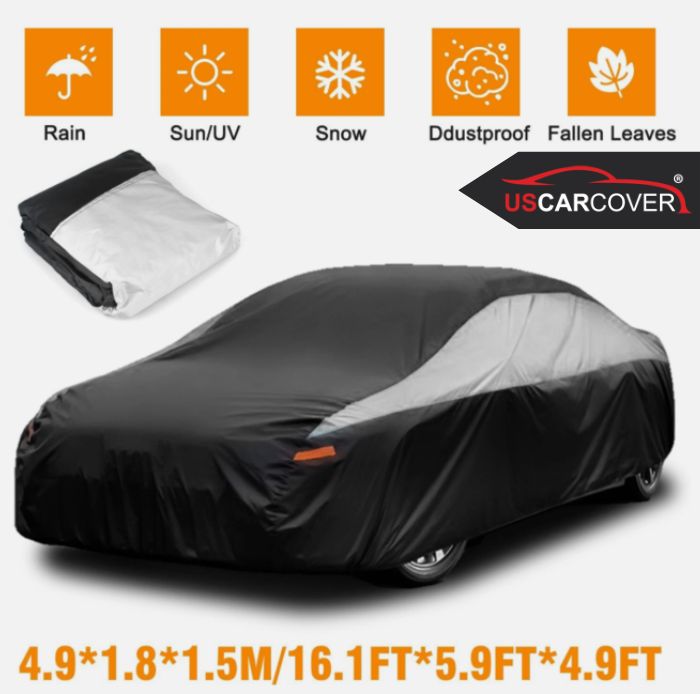
Every region in the U.S. sets a different test, and the way you pick a Hyundai car cover should follow what you face most often.
- Sun Belt: prioritize a reflective outer face and strong UV blocking to lower cabin heat and slow the aging of black plastics, seals and leather. A breathable core is mandatory to avoid heat and humidity build-up.
- Pacific Northwest: long, light rain is common. Choose stable beading so droplets leave quickly and micro-venting so the underside does not stay damp for days.
- Gulf Coast and coastal areas: the challenge is salty humidity. You need breathability so there is no salty greenhouse effect. Add a habit of shaking off salt each time you remove the cover.
- Great Plains and Rockies: wind is the engine of micro-movement. Prioritize a stay-still form, sensible anchor points, and recessed seams with soft hems so edges do not print onto curved glass.
- Northeast and Midwest: thunderstorms, leaf fall, wet snow and road salt arrive in seasons. Balance strong beading, breathing, and wind stability to get through all four seasons.
Shifting your criteria from “thick and sturdy feel” to “climate fit” gives you a much better chance of choosing the right Hyundai car cover the first time, cutting waste and increasing daily use.
Related Articles: Graham car cover: long-term storage solution with ultra soft liner, recessed seams, and breathability
EVs and technology: wide glass, dense sensors and a charge port that must be safe without trapping moisture
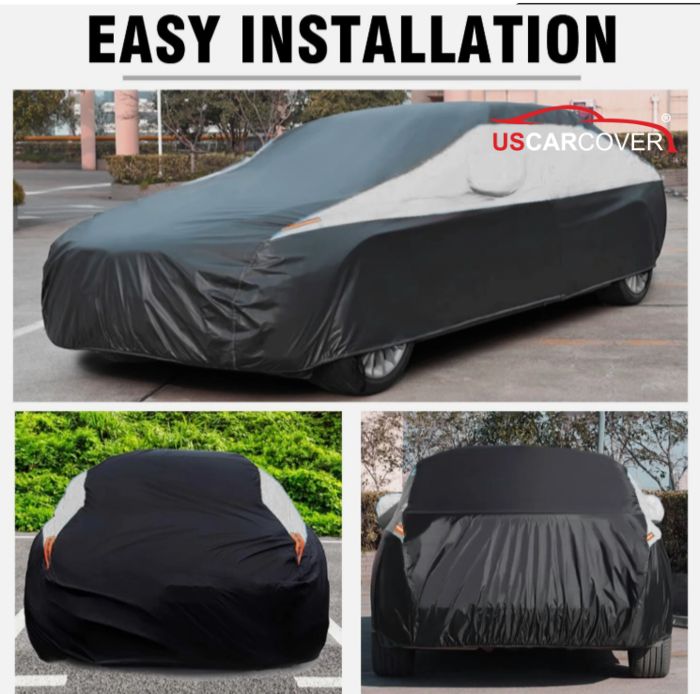
On Ioniq 5, Ioniq 6 and Kona Electric, large glass areas and many sensors demand more finesse. Sensors and cameras around the body are easy to scuff if the cover is loose. Big roof glass accumulates heat and is sensitive to local moisture build-up. The charge port area needs airflow so it does not trap dampness during long parking. If you choose poorly, you can get faint scuff lines at glass edges, localized dew around the port, and dirty sensors.
The fix is a Hyundai car cover that hugs the form, uses an ultra soft liner on large glass edges, breathes around the port, and reflects heat to lower cabin soak. When you need to charge, being able to open a corner or using a friendly access design keeps your daily cover habit intact instead of feeling like a hassle. This is the key. A good cover that is awkward to use does not help if you rarely put it on.
Interior and vulnerable surfaces: light seats, wood veneer, black plastics, chrome, seals
Inside the cabin, light-colored seats and wood veneer are sensitive to UV and heat, which makes them discolor and micro-crack. Outside, black plastics and rubber seals fade quickly under sun, and chrome and bright trim dislike salty humidity. These organic and metallic materials each have their own degradation pathways under radiation and moisture. The outcome is a prematurely “tired” interior, loss of depth on brightwork and a general feeling of wear after a few seasons.
A Hyundai car cover with the right mechanism tackles all fronts at once. Shading the roof and glass reduces radiation, lowers cabin temperature, and slows oxidation. Beading shortens wet time, breathing keeps the underside dry for days, and stability stops fine dust from rubbing. The result is light seats that hold their tone, veneer with fewer checks, black plastics that keep their color, brightwork with deeper shine, and rubber seals that stay supple without that hot plastic smell.
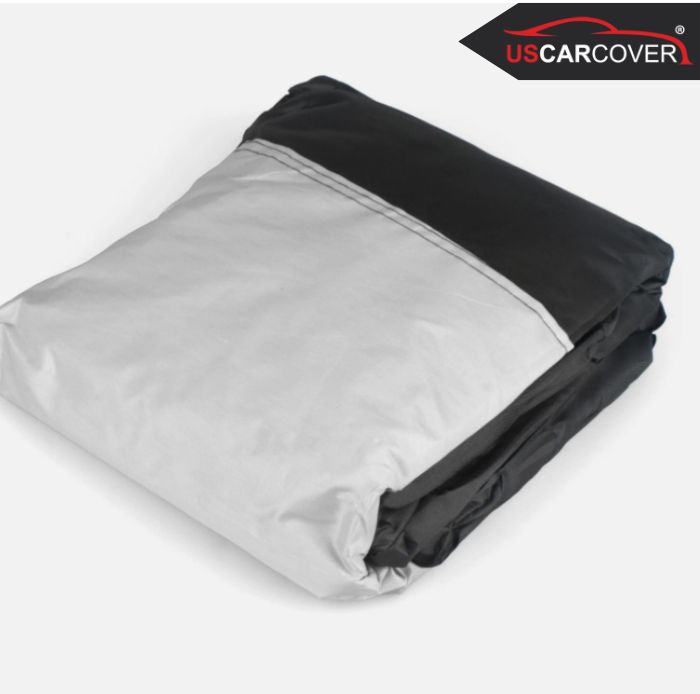
The economic angle: the cost of fixing once is usually higher than doing it right once
A single round of swirl correction, water-spot removal and chrome restoration at season’s end often equals or exceeds the price of a quality Hyundai car cover. If you have invested in PPF or ceramic, skipping a correctly engineered cover is like leaving the door open for sun, rain and dust to shorten the life of that protection. The economic logic is clear. The right cover avoids constant small bills and lengthens the cycles between larger maintenance jobs. The consequence of “saving in the wrong place” is that your total yearly spend is usually higher than a one-time investment in a proper Hyundai car cover.
Related Articles: How to choose a GMC car cover for Urban areas, the Sun Belt, the Snow Belt, coastal regions, and high-wind plateaus
Real-world situations you often face and how a Hyundai car cover resolves them
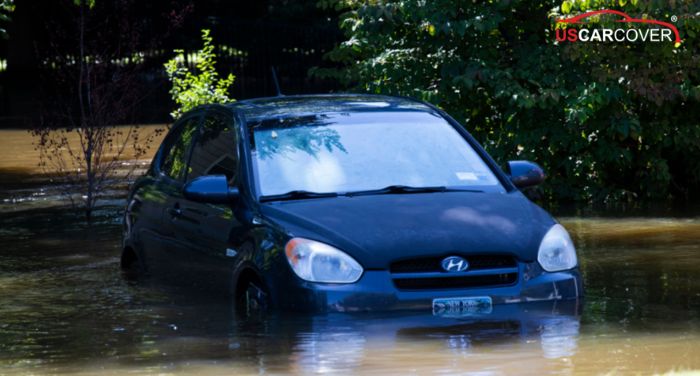
First is a driveway with sprinklers. Every morning brings hard water marks on glass and the hood. The cause is mineral-rich water drying in place. A Hyundai car cover with beading and breathing shortens wet time and removes the root cause of spotting. In a few days the chalky frames fade.
Second is a carport near a garden with high humidity. The cabin has a damp smell and glass edges show faint frames. An airtight cover turns the space into a greenhouse. Switch to a breathable cover and vapor has an escape path. The musty odor disappears and brightwork keeps its depth because it is not bathed in salty moisture.
Third is the Snow Belt after a storm. Brine sticks and cycles between freezing and thawing. If the cover moves, salt rubs and pits chrome. A Hyundai car cover with strong beading and a stable form addresses the cause. When you remove it, shake off salt before storage and the loop closes.
Fourth is Sun Belt midday parking. Cabin temps skyrocket and the wheel is too hot to touch. Shading roof and glass drops cabin temperature fast and reduces thermal shock to screens and the dash.
Fifth is a tree-lined city street. Sap, droppings and fine dust settle every night. A Hyundai car cover with a soft liner makes nightly covering easy, and contaminants never get a chance to set.
These scenarios show that with the right mechanism, a Hyundai car cover turns vehicle protection into an easy daily routine rather than a chore you avoid.
Related Articles: Geo car cover: reduce maintenance, protect 90s dashboards and plastics, and preserve resale value
Where to Buy a Quality Hyundai Car Cover

If you’re looking for a high-quality Hyundai car cover, a reliable place to start is uscarcover.com. This site offers custom-fit Hyundai car covers tailored to specific models, ensuring excellent protection against UV rays, dust, scratches, and moisture. Their covers use premium materials and are designed for both indoor and outdoor use. On uscarcover.com you’ll also find excellent service and support—fast nationwide shipping, flexible return policies, and expert guidance to help you pick the right Hyundai car cover for your parking conditions. Whether you park your Hyundai in a garage or outdoors, choosing the right car cover from this store means better long-term protection and peace of mind.
When you shift from “thicker is better” to “fabric engineered on physical mechanisms,” the Hyundai car cover shows a clear advantage. The outer face reflects radiation and beads water to fight sun and rain. The breathable core keeps the underside dry across days to block mildew and odor. The ultra soft liner and stable form stop scratches and swirl marks at the cause. All of it drives toward a single result. Your Hyundai ages more slowly through cycles of sun, rain, snow and dust. Once the Hyundai car cover becomes a daily habit, each install and removal is quick, tidy and clean, and your car looks new every day, preserving both utility and aesthetics through every climate across the United States.
